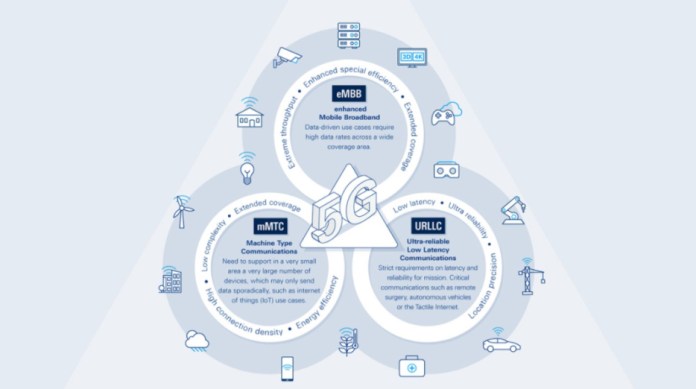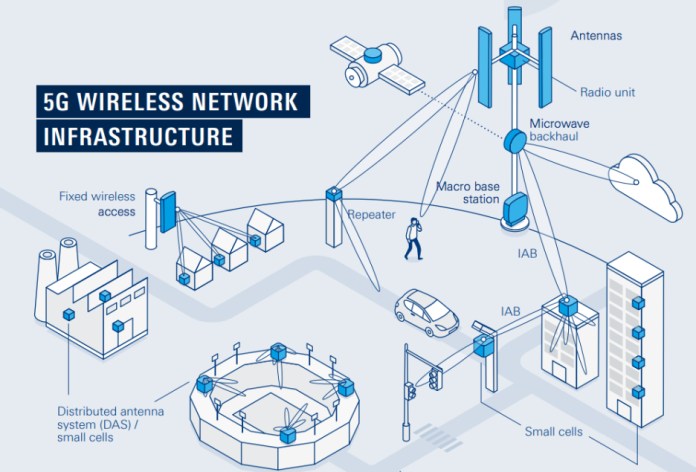5G continues to evolve and take shape as the next preeminent mobile wireless standard. As the basis for all 5G application fields, high-performance mobile network equipment is critical for success. 5G New Radio (NR) is the next generation of mobile networks and exploits new bands in Frequency Range 1 (FR1) from 410 MHz to 7.125 GHz and introduces higher frequencies in the mmWave range, referred to as Frequency Range 2 (FR2) from 24.25 GHz to 52.6 GHz.
There are many challenges associated with 5G. One of the biggest challenges is the sheer flexibility of 5G. Subcarrier spacing, symbol duration, cyclic prefix duration, bandwidth, frequencies from 400 MHz to 43.5 GHz, virtualized (core network) functions, and more make 5G incredibly complex. To fully test 5G, the test equipment also needs to be incredibly flexible to reduce the need for dozens of different 5G test solutions.
5G standardization and applications focused on enhanced mobile broadband (eMBB) are the first main use cases to facilitate faster data services for end users. Enabling eMBB requires the use of technologies such as beamforming that entail certain design challenges for mobile network infrastructure equipment.
The other two main use cases are massive machine-type communications (mMTC) and ultra-reliable, low-latency communications (URLLC). The mMTC use case supports fast and unlimited connections of large numbers of devices such as required for internet-of-things applications. For URLLC, reliable communications and low latency are the key topics, which are mandatory for vertical applications such as industrial IoT and autonomous driving.

5G’s first focus applications for eMBB, mMTC, and URLLC (Source: Rohde & Schwarz)
Infrastructure trends
Flexibility
The user device evolution from a plain telephone to an application-driven device supporting various use cases necessitates a flexible infrastructure that can cope with 5G service requirements associated with eMBB, URLLC, and mMTC. While software-defined network methods allow virtualization of functions, the actual functions will be decoupled from a direct hardware binding. This means that network functions are no longer regulated to specific hardware elements in the network. Some network functions may be implemented in the cloud, while others may be implemented in hardware.
Disaggregated networks and open interfaces enable a multi-vendor concept and speed up new service introductions. The objective is to make the network smart, agile, and flexible. 5G standalone and non-standalone deployment strategies require flexible hardware to work with the 2G, 3G, and 4G legacy technologies. The ever-increasing technical requirements of 5G along with system complexity make it necessary to rely on future-proof test equipment and dedicated, application-optimized test solutions for the entire life cycle.
Network densification
Ever-increasing demand for higher data rates is driving macro cells to their limits. Network densification makes it possible to cope with the challenging capacity requirements by complementing macro cells. Depending on the available frequency spectrum and implementation regulations, network-densification solutions range from low-power small cells to distributed antenna systems and mmWave solutions. As one of the first use cases for 5G mmWave applications, last-mile fixed wireless access uses the massively increased capacity to bring broadband to private homes.
In addition to supporting the new frequency bands of FR2, test equipment has to remain agile enough to support all of the various stages and phases of 5G such as the ongoing coexistence with LTE, the use of dynamic spectrum sharing, and the transition from NSA to SA. New latency and reliability requirements for campus networks also need to be tested and verified. Over-the-air testing, as opposed to conducted testing, is now a necessity at the cell site for ensuring quality metrics with the widespread adoption of beamforming.

The 5G wireless infrastructure encompasses a network of macro- and small-cell base stations. (Source: Rohde & Schwarz)
Evolving mobile network architecture
The importance of 5G mobile network infrastructure is growing along with the need for reliable network performance in various use cases, ranging from sporadic data bursts to fast and reliable low-latency transmission. Trends like cloudification, disaggregation, and multi-access edge computing are targeting smart, agile, and flexible networks. The challenge is to bridge the gap between centralization, lower energy consumption, and lower complexity versus hierarchical disaggregated network deployment fostering low latency, intelligent RAN control, and quality of service (QoS)-optimized scheduling aspects.
The 3GPP’s integrated access and backhaul feature enables access and backhaul via the same 5G air interface technology, leveraging fast deployment of infrastructure components. Ubiquitous connection is an important goal to bring connectivity to rural areas and IoT networks in remote locations, fostering non-terrestrial networks.
Recommended
Reliable network measurements enable QoE improvements
Private/local networks
Industries such as production facilities can use 5G technology to create a local or private network within a dedicated area. Based on network slicing or individual industry-owned networks, private networks feature unified connectivity, use-case optimized services, and a secure environment. Governments have begun to provide specific spectrum allocations for private networks. Network operators can offer a non-public network as a virtualized network as a service to their customers.
Depending on whether the tests will be done by the network owner or be outsourced to the mobile operator or some other third party, testing will have to become part of the process of owning and operating a private network to ensure network quality, performance, and reliability.
Test challenges
Component R&D
Developing wireless network equipment starts with testing RF components (power amplifier, RF front end, D/A converter, filter, antenna arrays) and verifying the digital signal processing and power modules. Typically, continuous-wave signals are used to characterize RF performance metrics such as S-parameters. More sophisticated methods are increasingly applied to perform testing with modulated signals. Advanced techniques such as digital predistortion help achieve optimal performance.
Design and validation
Design and validation testing helps ensure the functional performance of components, subsystems, and systems over a wide range of conditions. Test sequences can have a large scope and cover multiple parameters such as frequency, power, beams, and temperature. This includes the power and modulation performance of components and transmitters, beamforming accuracy (e.g., beam direction and power), and signal integrity over high-speed digital interfaces.
Integration and verification
Integration and verification tests cover the complete base station as well as its subsystems. 5G test challenges include antenna complexity, expanding bandwidth, and higher frequencies. Testing includes spherical radiation patterns, total radiated power, transmitter characteristics, and receiver performance, including a performance analysis over a large temperature range for all signals. The focus is on feature sets and the completeness of tests. The measurements can run 24/7/365. Test scenarios are automated. The scope of the tests is significantly wider than as defined by the 3GPP specifications, requiring high-end test equipment and large anechoic chambers.

5G brings new testing challenges with antenna complexity, expanding bandwidth, and higher frequencies. (Source: Rohde & Schwarz)
Bringing 5G network equipment to market
Conformance approval
Standardization bodies, such as 3GPP, specify conformance tests to ensure that base stations operate within well-defined RF and performance constraints. The conformance tests specified by 3GPP cover transmitter and receiver characteristics, as well as receiver performance under noise and fading conditions. Regulatory authorities, such as the FCC, OFCOM, and BNetzA, typically set the limits for these tests. Base stations need to pass conformance tests in the region where they will be installed before they can start operation in the field.
Production tests
Production tests involve two stages: subsystem and complete system testing. First, systems are calibrated. This includes application of a signal with a known level, device programming to report the correct signal level, and filter tuning or setting of internal attenuation to generate the correct output power. Afterward, the performance is verified.
Production tests are designed to ensure product quality independent of 3GPP tests. Because throughput and efficiency are critical, high-speed instruments with top performance and compact footprints are essential. Production tests are also increasingly parallelized and automated for higher levels of throughput.
Network installation and mobile network testing
Each new cell site needs to be verified to ensure correct network performance and QoS. A typical site acceptance procedure involves spectrum measurements conducted over the air to analyze the transmitter in the frequency and time domains and troubleshoot issues.
5G has a new requirement for functional tests that verify the connection to the network and gather performance KPIs such as latency, download speed, and upload speed using a smartphone. Finally, signal decoding is used to verify network information and synchronization signals for the 5G and LTE anchor signals. Once the network is operational, any technical issues can be diagnosed and resolved using functional, spectral, and signal decoding procedures.
Conclusion
Technological innovations have led to innovative test and measurement solutions that allow customers to launch 5G products more quickly and safely. The latest enhancements make it possible to generate and analyze 5G NR sub-6-GHz and mmWave signals.
As mobile technology continues to evolve, testing for design validation and/or volume production becomes a more critical task. Network operators and device OEMs must be able to evaluate and certify the reliability and performance characteristics of devices and base stations in environments that closely resemble the one in which they are actually used. No doubt, 6G will bring even more complexity and challenges ahead, with its intended use of terahertz frequencies, or the possibility of new, highly efficient channel encoding and the use of sophisticated antenna mesh technologies.
Advertisement
Learn more about Rohde & Schwarz





